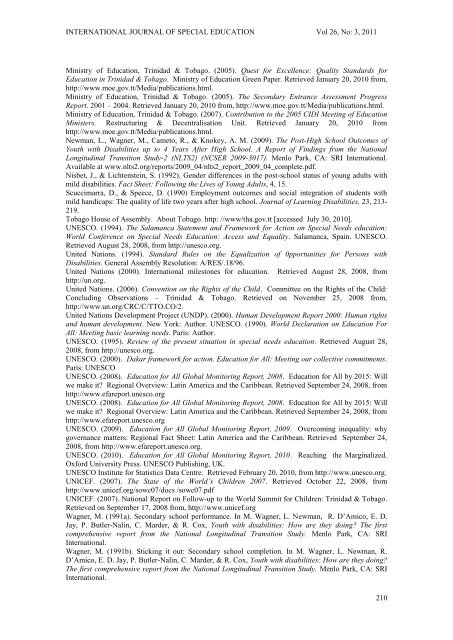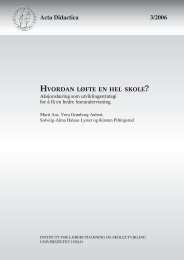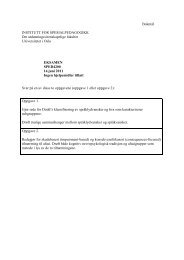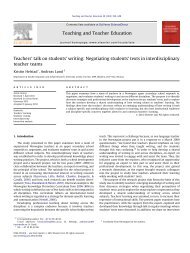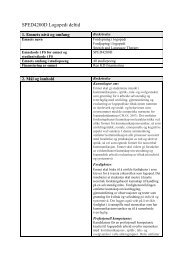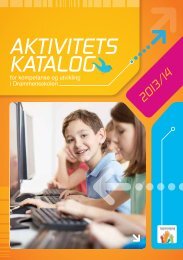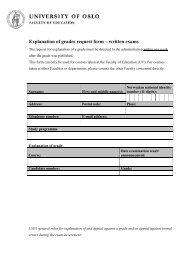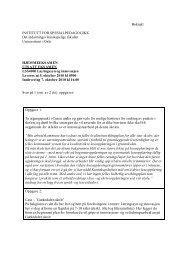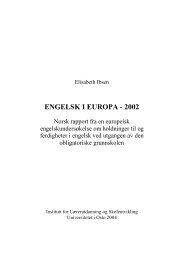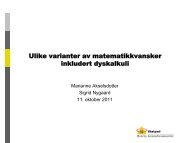International Journal Special Education
International Journal Special Education
International Journal Special Education
You also want an ePaper? Increase the reach of your titles
YUMPU automatically turns print PDFs into web optimized ePapers that Google loves.
INTERNATIONAL JOURNAL OF SPECIAL EDUCATION Vol 26, No: 3, 2011Ministry of <strong>Education</strong>, Trinidad & Tobago. (2005). Quest for Excellence: Quality Standards for<strong>Education</strong> in Trinidad & Tobago. Ministry of <strong>Education</strong> Green Paper. Retrieved January 20, 2010 from,http://www.moe.gov.tt/Media/publications.html.Ministry of <strong>Education</strong>, Trinidad & Tobago. (2005). The Secondary Entrance Assessment ProgressReport. 2001 – 2004. Retrieved January 20, 2010 from, http://www.moe.gov.tt/Media/publications.html.Ministry of <strong>Education</strong>, Trinidad & Tobago. (2007). Contribution to the 2005 CIDI Meeting of <strong>Education</strong>Ministers. Restructuring & Decentralisation Unit. Retrieved January 20, 2010 fromhttp://www.moe.gov.tt/Media/publications.html.Newman, L., Wagner, M., Cameto, R., & Knokey, A. M. (2009). The Post-High School Outcomes ofYouth with Disabilities up to 4 Years After High School. A Report of Findings from the NationalLongitudinal Transition Study-2 (NLTS2) (NCSER 2009-3017). Menlo Park, CA: SRI <strong>International</strong>.Available at www.nlts2.org/reports/2009_04/nlts2_report_2009_04_complete.pdf.Nisbet, J., & Lichtenstein, S. (1992). Gender differences in the post-school status of young adults withmild disabilities. Fact Sheet: Following the Lives of Young Adults, 4, 15.Scuccimarra, D., & Speece, D. (1990) Employment outcomes and social integration of students withmild handicaps: The quality of life two years after high school. <strong>Journal</strong> of Learning Disabilities, 23, 213-219.Tobago House of Assembly. About Tobago. http: //www/tha.gov.tt [accessed July 30, 2010].UNESCO. (1994). The Salamanca Statement and Framework for Action on <strong>Special</strong> Needs education:World Conference on <strong>Special</strong> Needs <strong>Education</strong>: Access and Equality. Salamanca, Spain. UNESCO.Retrieved August 28, 2008, from http://unesco.org.United Nations. (1994). Standard Rules on the Equalization of 0pportunities for Persons withDisabilities. General Assembly Resolution: A/RES/.18/96.United Nations (2000). <strong>International</strong> milestones for education. Retrieved August 28, 2008, fromhttp://un.org.United Nations. (2006). Convention on the Rights of the Child. Committee on the Rights of the Child:Concluding Observations – Trinidad & Tobago. Retrieved on November 25, 2008 from,http://www.un.org/CRC/C/TTO.CO/2.United Nations Development Project (UNDP). (2000). Human Development Report 2000: Human rightsand human development. New York: Author. UNESCO. (1990). World Declaration on <strong>Education</strong> ForAll: Meeting basic learning needs. Paris: Author.UNESCO. (1995). Review of the present situation in special needs education. Retrieved August 28,2008, from http://unesco.org.UNESCO. (2000). Dakar framework for action. <strong>Education</strong> for All: Meeting our collective commitments.Paris: UNESCOUNESCO. (2008). <strong>Education</strong> for All Global Monitoring Report, 2008. <strong>Education</strong> for All by 2015: Willwe make it? Regional Overview: Latin America and the Caribbean. Retrieved September 24, 2008, fromhttp://www.efareport.unesco.orgUNESCO. (2008). <strong>Education</strong> for All Global Monitoring Report, 2008. <strong>Education</strong> for All by 2015: Willwe make it? Regional Overview: Latin America and the Caribbean. Retrieved September 24, 2008, fromhttp://www.efareport.unesco.orgUNESCO. (2009). <strong>Education</strong> for All Global Monitoring Report, 2009. Overcoming inequality: whygovernance matters: Regional Fact Sheet: Latin America and the Caribbean. Retrieved September 24,2008, from http://www.efareport.unesco.org.UNESCO. (2010). <strong>Education</strong> for All Global Monitoring Report, 2010. Reaching the Marginalized.Oxford University Press. UNESCO Publishing, UK.UNESCO Institute for Statistics Data Centre. Retrieved February 20, 2010, from http://www.unesco.org.UNICEF. (2007). The State of the World’s Children 2007. Retrieved October 22, 2008, fromhttp://www.unicef.org/sowc07/docs /sowc07.pdfUNICEF. (2007). National Report on Follow-up to the World Summit for Children: Trinidad & Tobago.Retrieved on September 17, 2008 from, http://www.unicef.orgWagner, M. (1991a). Secondary school performance. In M. Wagner, L. Newman, R. D’Amico, E. D.Jay, P. Butler-Nalin, C. Marder, & R. Cox, Youth with disabilities: How are they doing? The firstcomprehensive report from the National Longitudinal Transition Study. Menlo Park, CA: SRI<strong>International</strong>.Wagner, M. (1991b). Sticking it out: Secondary school completion. In M. Wagner, L. Newman, R.D’Amico, E. D. Jay, P. Butler-Nalin, C. Marder, & R. Cox, Youth with disabilities: How are they doing?The first comprehensive report from the National Longitudinal Transition Study. Menlo Park, CA: SRI<strong>International</strong>.210


